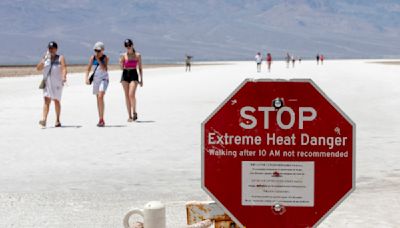Search results
- www.mayoclinic.org
- › …
- › Diseases & Conditions
Jun 25, 2022 · This most serious form of heat injury, heatstroke, can occur if your body temperature rises to 104 F (40 C) or higher. The condition is most common in the summer months. Heatstroke requires emergency treatment. Untreated heatstroke can quickly damage your brain, heart, kidneys and muscles.
Heat stroke or heatstroke, also known as sun-stroke, is a severe heat illness that results in a body temperature greater than 40.0 °C (104.0 °F), along with red skin, headache, dizziness, and confusion.
Nov 1, 2021 · The medical definition of heat stroke is a core body temperature greater than 104 F, with complications involving the central nervous system that occur after exposure to high temperatures. Other...
Sep 13, 2021 · It’s defined as a body temperature above 104 degrees Fahrenheit (40 degrees Celsius). Heatstroke, also called sunstroke, is the most severe form of hyperthermia, or heat-related illness. Heatstroke can lead to brain damage, organ failure or death.
Jan 19, 2023 · Heatstroke is the most serious type of heat injury that can occur. It’s caused by overheating of the body to a core temperature of 104°F (40°C) or higher.
- www.mayoclinic.org
- › …
- › Diseases & Conditions
Jun 25, 2022 · If you notice signs of heat-related illness, lower your body temperature and prevent your condition from progressing to heatstroke. In a lesser heat emergency, such as heat cramps or heat exhaustion, the following steps may lower your body temperature: Get to a shady or air-conditioned place.
- www.mayoclinic.org
- › …
- › Diseases & Conditions
Apr 6, 2023 · Heat exhaustion is a condition that happens when your body overheats. Symptoms may include heavy sweating and a rapid pulse. Heat exhaustion is one of three heat-related illnesses, with heat cramps being the mildest and heatstroke being the most serious.
Heat stroke is the most serious heat-related illness. It occurs when the body can no longer control its temperature: the body’s temperature rises rapidly, the sweating mechanism fails, and the body is unable to cool down.
Feb 15, 2024 · Heat stroke. What to look for. High body temperature (103°F or higher) Hot, red, dry, or damp skin. Fast, strong pulse. Headache. Dizziness. Nausea. Confusion. Losing consciousness (passing out) What to do. Call 911 right away-heat stroke is a medical emergency. Move the person to a cooler place.
Jul 27, 2022 · Heat stroke is a severe medical emergency. Summon emergency medical assistance or get the individual to a hospital immediately. Delay can be fatal. Move individual to a cooler, preferably air-conditioned, environment. Reduce body temperature with a water mister and fan or sponging. Use air conditioners.




